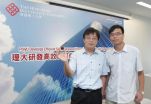Pitt researcher lands the cover of Developmental Cell by uncovering an evolutionary secret
Mark Rebeiz delves into the reuse of gene regulatory networks
2015-09-08
(Press-News.org) PITTSBURGH--How did the elephant get its trunk? Or the turtle its shell? How, in general, did the seemingly infinite diversity of complex animal forms on our planet arise? The scientific pursuit of how such "evolutionary novelties" come about is one of the big mysteries that biologists are trying to tease apart.
The University of Pittsburgh's Mark Rebeiz and colleagues provide some answers in a paper published today in the journal Developmental Cell.
Even in the most complex organisms, the genetic repertoire is limited. If creatures don't evolve by acquiring new genes, how do new anatomical structures arise? Physical structures--organs, limbs, etc.--are encoded during development through the actions of collections of genes that work together in "networks." Connections between genes in these networks take form primarily via gene products binding and controlling gene activation at regulatory sequences known as "switches." These switches function as a blueprint for how to build an organism. They represent information that can be exploited to understand a network's evolutionary beginnings.
Rebeiz, an assistant professor of evolutionary development in Pitt's Department of Biological Sciences within the Kenneth P. Dietrich School of Arts and Sciences, used these switches to uncover the origins of a recently evolved structure called the posterior lobe--part of the genitalia of a certain kind of male fruit fly. Other fruit flies lack these lobes, making it a simple test system to study how an anatomical structure originated.
How does a particular structure, and its network, originate without the evolution of new genes? The answer is to reuse, or "co-opt" a network that was already being used at another time and place during development.
Rebeiz and colleagues found that a switch that activates a critical factor of the posterior lobe's network could be traced to another network active during an earlier life stage. This led his team to find that several genes of the network that makes the posterior spiracle, a structure that connects the larval breathing system to the outside world, were redeployed during genital development through their posterior spiracle switches.
"How do you make something completely new?" asks Rebeiz. The answer, it seems, is to use something old. "By tracing the evolution of a network's switches," he says, "we can see how new structures are built from networks we never would have imagined to be related."
INFORMATION:
ELSE PRESS RELEASES FROM THIS DATE:
2015-09-08
DURHAM, N.C. -- Teenagers are irrational and make bad decisions. Or do they? A new Duke study finds that adolescents ages 10 to 16 can be more analytical in their economic choices than many slightly older young adults.
Published online in the October-December issue of Cognitive Development, the study suggests not only that society should give adolescents more credit for rationality but also that parents should help children hone their cost-benefit analysis skills in making real-life decisions.
"The new results point to the idea that we should not think of adolescents ...
2015-09-08
ROCHESTER, Minn. -- Low-risk cancers that do not have any symptoms and presumably will not cause problems in the future are responsible for the rapid increase in the number of new cases of thyroid cancer diagnosed over the past decade, according to a Mayo Clinic study published in the journal Thyroid. According to the study authors, nearly one-third of these recent cases were diagnosed when clinicians used high-tech imaging even when no symptoms of thyroid disease were present.
"We are spotting more cancers, but they are cancers that are not likely to cause harm," says ...
2015-09-08
This news release is available in French. Chemical substances that are safe for humans when taken in isolation can become harmful when they are combined. Three research teams bringing together researchers from Inserm and CNRS in Montpellier have elucidated in vitro a molecular mechanism that could contribute to the phenomenon known as the "cocktail effect." This study is published in the journal Nature Communications.
Every day we are exposed to many exogenous compounds such as environmental pollutants, drugs or substances in our diet. Some of these molecules, known ...
2015-09-08
Got rope? Then try this experiment: Cross both ends, left over right, then bring the left end under and out, as if tying a pair of shoelaces. If you repeat this sequence, you get what's called a "granny" knot. If, instead, you cross both ends again, this time right over left, you've created a sturdier "reef" knot.
The configuration, or "topology," of a knot determines its stiffness. For example, a granny knot is much easier to undo, as its configuration of twists creates weaker forces within the knot, compared with a reef knot. For centuries, sailors have observed such ...
2015-09-08
WORCESTER, MA -- Researchers at the University of Massachusetts Medical School are the first to show that it's possible to reverse the behavior of an animal by flipping a switch in neuronal communication. The research, published in PLOS Biology, provides a new approach for studying the neural circuits that govern behavior and has important implications for how scientists think about neural connectomes.
New technologies have fueled the quest to map all the neural connections in the brain to understand how these networks processes information and control behavior. The human ...
2015-09-08
SALT LAKE CITY, Sept. 7, 2015 - If you are in a special relationship with another person, thank grandma - not just yours, but all grandmothers since humans evolved.
University of Utah anthropologist Kristen Hawkes is known for the "grandmother hypothesis," which credits prehistoric grandmothering for our long human lifespan. Now, Hawkes has used computer simulations to link grandmothering and longevity to a surplus of older fertile men and, in turn, to the male tendency to guard a female mate from the competition and form a "pair bond" with her instead of mating with ...
2015-09-08
Physicists from the Department of Nanophotonics and Metamaterials at ITMO University have experimentally demonstrated the feasibility of designing an optical analog of a transistor based on a single silicon nanoparticle. Because transistors are some of the most fundamental components of computing circuits, the results of the study have crucial importance for the development of optical computers, where transistors must be very small and ultrafast at the same time. The study was published in the scientific journal Nano Letters.
The performance of modern computers, which ...
2015-09-08
Developing transparent or semitransparent solar cells with high efficiency and low cost to replace the existing opaque and expensive silicon-based solar panels has become increasingly important due to the increasing demands of the building integrated photovoltaics (BIPVs) systems. The Department of Applied Physics of The Hong Kong Polytechnic University (PolyU) has successfully developed efficient and low-cost semitransparent perovskite solar cells with graphene electrodes. The power conversion efficiencies (PCEs) of this novel invention are around 12% when they are illuminated ...
2015-09-08
Calculation with electron spins in a quantum computer assumes that the spin states last for a sufficient period of time. Physicists at the University of Basel and the Swiss Nanoscience Institute have now demonstrated that electron exchange in quantum dots fundamentally limits the stability of this information. Control of this exchange process paves the way for further progress in the coherence of the fragile quantum states. The report from the Basel-based researchers appears in the scientific journal Physical Review Letters.
The basic idea of a quantum computer is to ...
2015-09-08
DENVER, Colo. -- The International Association for the Study of Lung Cancer (IASLC) today issued a new statement on Tobacco Control and Smoking Cessation at the 16th World Conference on Lung Cancer (WCLC) in Denver. The statement calls for higher taxes on tobacco products, comprehensive advertising and promotion bans of all tobacco products and product regulation including pack warnings.
"Tax policies that increased the cost of cigarettes have played a prominent role in the reduction of cigarette smoking," said Dr. Kenneth Michael Cummings, Professor, Hollings Cancer ...
LAST 30 PRESS RELEASES:
[Press-News.org] Pitt researcher lands the cover of Developmental Cell by uncovering an evolutionary secret
Mark Rebeiz delves into the reuse of gene regulatory networks


